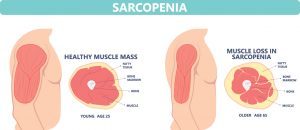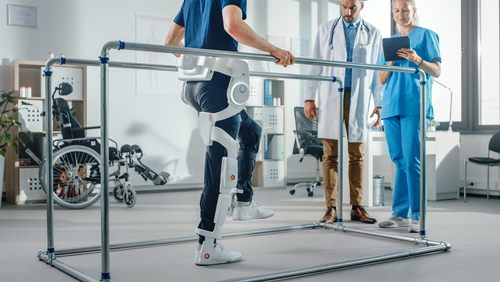WORDS DR NIZAR ABDUL MAJEED KUTTY
 FEATURED EXPERT FEATURED EXPERTDR NIZAR ABDUL MAJEED KUTTY Senior Lecturer Department of Physiotherapy Universiti Tunku Abdul Rahman (UTAR) |
People with diabetes are living longer now, which is incredibly exciting. Still, they are vulnerable to accelerated muscle loss or sarcopenia, an often-overlooked condition that occurs in people with type 2 diabetes.
MUSCLE LOSS IS NORMAL WHEN WE AGE
It is normal for individuals to lose 3% to 8% of their muscle mass per decade beginning at age 30, and the rate of decline is even higher after the about age 60. Muscle strength declines even more rapidly; at a rate of 3% to 4% per year in men and 2.5% to 3% per year in women by the age of 75.
HOWEVER, PEOPLE WITH TYPE 2 DIABETES ARE LIKELY TO EXPERIENCE ACCELERATED MUSCLE LOSS OR SARCOPENIA
While some muscle loss is typical, sarcopenia refers to a condition of accelerated muscle loss.

Earlier definitions of sarcopenia focused exclusively on loss of muscle mass as the key determinant of the condition, but more recent definitions have recognized that muscle strength and function are equally important for predicting adverse outcomes.
Thus, newer definitions for sarcopenia have included low walking speed and grip strength alongside low muscle mass.
Sarcopenia is associated with an increased risk of falls, functional decline, frailty, and mortality.
THE LINK BETWEEN SARCOPENIA AND TYPE 2 DIABETES
The link is well established.
In a study of Korean adults, 15.7% of participants with diabetes were found to have sarcopenia, compared with just 6.9% of participants without diabetes.
A later study led by the same author, also in Korea, produced similar findings: in a sample of 414 adults aged 65 or older, participants with type 2 diabetes had significantly lower muscle mass.
A link between low muscle mass and diabetes has been found in several other populations as well.
Multiple studies have also linked diabetes to reduced muscle strength. The effect sizes were smaller in women, but the trend was the same for both genders.
This association between sarcopenia and diabetes has led some researchers to argue that sarcopenia is probably one of the underlying mechanisms that explains the reduced functional ability and mobility that is often seen in older patients with type 2 diabetes.
HOW TYPE 2 DIABETES LEADS TO SARCOPENIA
While diabetes accelerates the process of muscle loss, the mechanisms aren’t yet thoroughly understood.
The presence of insulin resistance, which is the key feature of type 2 diabetes, appears to be a major pathway.
Inability to make new proteins at a rapid pace to replace muscles that have been degraded naturally
One of the key roles of insulin is to drive nutrients, such as glucose, from the blood into skeletal muscle tissues and stimulate protein synthesis.
In type 2 diabetes, however, insulin signaling is impaired; insulin is not able to effectively drive glucose into the muscle tissues, and the muscles cannot synthesize new protein rapidly enough to keep pace with natural muscle degradation.
Decreased function of mitochondria
The mitochondrion is the ‘energy plant’ structure in most cells of the body.
Individuals with diabetes frequently have decreased mitochondrial function, which appears to contribute to the impairment of muscle function.
Type 2 diabetes can damage the nerves outside of the brain and spinal cord, usually at the hands and feet (peripheral neuropathy)
Diabetes can promote sarcopenia via peripheral neuropathy. This condition can affect nerves that control proper muscle contraction.
Approximately 30% to 50% of diabetes mellitus patients experience peripheral neuropathy, and the condition has been shown to be an independent risk factor for sarcopenia in individuals with diabetes.
Other possible factors?
Still, other factors also may play a role in causing muscle loss in the context of diabetes.
Thus, a wide variety of factors likely contribute to the connection between diabetes and sarcopenia. Some data suggest that these varying mechanisms come into play even in individuals who are comparatively young or who are comparatively early in the disease process.
CAN LOWERING BLOOD GLUCOSE HELP PREVENT MUSCLE LOSS?
The growing body of research on the connection between diabetes and sarcopenia has raised an important question of whether lowering blood glucose help preserve muscle mass.
There’s currently little research on that question, but diabetes medications that control blood glucose levels likely do have a role to play in treating and preventing muscle loss among older adults with diabetes.
However, key clinical trials on which clinical management guidelines for blood glucose have been based on unfortunately often exclude the participation of older adults, so there’s no way to know at present.
Hence, future research is needed to better understand the effects of glucose-lowering on muscle mass in older adults.
THE ROLE OF EXERCISE
While diabetes medications may have a role to play in lowering blood glucose and in staving off muscle loss, no medication is as beneficial for treating sarcopenia as physical activity.
Physical activity is always recommended to promote fat loss and maintain muscle mass, both of which can improve glucose levels in people with type 2 diabetes.
This recommendation applies equally to both younger and older adults.
Researchers especially recommend muscle strengthening exercise and resistance activities.
Progressive resistance training is the proven method for the prevention and improvement of sarcopenia.
Resistance exercises in more detail
Resistance training doesn’t require more than your own body weight.
Using resistance to engage the muscles causes a surge in growth-promoting hormones that signal the body to produce more muscle tissues.
Not only do these signals encourage the growth of new muscle tissue, but they also help to reinforce existing muscle tissues by making them stronger.
Some body weight resistance exercises that you can try include:
- Push-ups; try an easier version with your knees on the ground, if you need to.
- Planks.
- Squats.
- Lunges.
With progressive resistance training, you need to exercise your muscles against an increasing external force 2 to 3 times a week for at least 8 to 12 weeks.
This is progressive, meaning that the number of repetitions, sets, or load should be increased gradually over time based on your capabilities and progress.
As the resistance exercises programme develops, more advanced resistance exercises that can be done include barbells, kettlebells, and medicine balls or floor-based exercises.
In terms of exercise order, the American College of Sports Medicine (ACSM) recommends multi-joint exercises to be performed before single-joint exercises for a particular muscle group, and that within each session the larger muscle groups be exercised before smaller muscle groups.
As older adults with sarcopenia are also likely to be at an increased risk for falls and display reduced cardiorespiratory fitness, exercise programmes for them often involve a combination of exercise modes that includes resistance exercises, balance training and aerobic training.
For older adults with sarcopenia
Consider:
- Walking around the block 4 to 5 times.
- Do some weight lifting.
- Sit on and get up from a chair as fast as possible and do this 10 times in a row and getting up ten times in a row as fast as possible.
| If you are not used to being physically active, or you have health conditions that can affect your ability to exercise, consider consulting a physiotherapist or a personal trainer to advice. They can help you develop an exercise programme tailored to your needs, health status, and personal enjoyment. |







